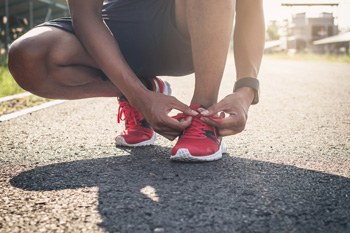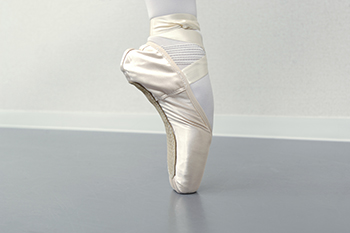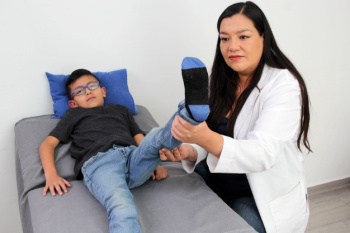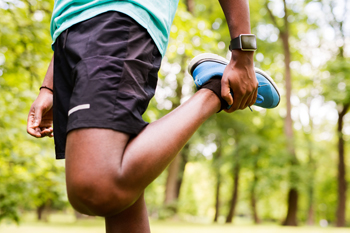Items filtered by date: September 2024
Getting Running Shoes That Fit
 Finding the right pair of running shoes is key to enjoying a comfortable and injury-free run. Start by understanding your foot shape and width, as well as the type of terrain you'll be running on. Different surfaces, such as roads, tracks, or trails, require specific shoes to provide the necessary support and cushioning. Knowing your pronation type, or how your foot rolls when you walk or run, is also important. A chiropodist can conduct a gait analysis to determine your pronation type and suggest the possible use of orthotics. Proper fit includes ensuring extra toe room. Also, your running shoes should be about a half size larger than your regular shoes to accommodate foot expansion during long runs. The shoe should be snug but not too tight. With various widths available, you can find a shoe that matches your foot's dimensions. Also, consider the weight of both the shoe and your body. Heavier runners may need more supportive shoes, while all runners benefit from lighter shoes for greater comfort over long distances. Try shoes on in the evening, when your feet are naturally slightly larger, and wear proper running socks for a better fit. If you suffer from foot pain after running, it is suggested that you make an appointment with a chiropodist for an exam and treatment options.
Finding the right pair of running shoes is key to enjoying a comfortable and injury-free run. Start by understanding your foot shape and width, as well as the type of terrain you'll be running on. Different surfaces, such as roads, tracks, or trails, require specific shoes to provide the necessary support and cushioning. Knowing your pronation type, or how your foot rolls when you walk or run, is also important. A chiropodist can conduct a gait analysis to determine your pronation type and suggest the possible use of orthotics. Proper fit includes ensuring extra toe room. Also, your running shoes should be about a half size larger than your regular shoes to accommodate foot expansion during long runs. The shoe should be snug but not too tight. With various widths available, you can find a shoe that matches your foot's dimensions. Also, consider the weight of both the shoe and your body. Heavier runners may need more supportive shoes, while all runners benefit from lighter shoes for greater comfort over long distances. Try shoes on in the evening, when your feet are naturally slightly larger, and wear proper running socks for a better fit. If you suffer from foot pain after running, it is suggested that you make an appointment with a chiropodist for an exam and treatment options.
The right running shoes can sometimes be difficult to find. With so many options on the market, it’s important to know the unique needs of your feet prior to buying running shoes. If you require assistance, please consult with one of the chiropodists from Complete Family Footcare & Therapy. Our clinicians can help you maintain the health of your lower limbs and your mobility.
When looking for running shoes, take into consideration:
The type of running you will be doing
The terrain you plan to run on
Your gait or running pattern
Your arch type
Other unique foot needs
A chiropodist can help by examining your feet and your gait to determine what types of shoes may be best for you. Some runners may require motion control shoes, which prevent your foot from rolling too far inward while you run. Others may need stability shoes, which offer more balance, cushioning, and support. When shopping for shoes, make sure that they are the right size, fit comfortably, and are made of breathable materials.
If you have any questions, please feel free to contact our offices located in . We offer the newest diagnostic and treatment technologies for all your foot care needs.
Finding the Perfect Dance Shoe

Selecting the right dance shoe is essential for both performance and foot health. Ballet slippers should fit snugly without pinching, allowing for flexibility and proper arch support. Pointe shoes require meticulous fitting to avoid pain and potential injury, and they must support the foot correctly while accommodating the dancer’s natural foot shape. Jazz shoes should be snug yet comfortable, providing good grip and flexibility. Tap shoes need a secure fit to ensure accurate sound production and prevent blisters. Ballroom shoes should offer both style and support, fitting securely without slipping. Wearing ill-fitting dance shoes can lead to foot problems, such as blisters, calluses, bunions, and even long-term issues like tendonitis. If you have developed a foot condition from wearing dance shoes that do not fit correctly, it is suggested that you confer with a chiropodist who can help you to find relief and educate you on how to choose shoes that fit properly.
Finding the right shoes for you can ensure your comfort and help maintain proper foot health. If you suffer from foot pain and need help finding the right shoes for you, please consult with one of the chiropodists from Complete Family Footcare & Therapy. Our clinicians will assess your condition and provide you with quality foot and ankle treatment.
Tips to Find Great Shoes
Finding shoes that are well-fitting, supportive, and comfortable can be key in maintaining your overall foot health, but can sometimes seem like a monumental task.
Here are some tips and tricks to keep in mind when shopping for shoes.
Shop in a brick and mortar store - Your shoe size can change throughout your lifetime. You will be able to try on shoes before you buy them to ensure a proper fit. A salesperson can also provide recommendations on what shoes best serve your specific needs.
Try shoes on at the end of the day - Your feet swell throughout the day. By trying shoes on in the evening when the feet are at their largest, you ensure a good fit and shoes that are comfortable all day.
Have your feet measured - Find the right fit by having your feet measured at the shoe store. A salesperson can help by measuring both feet with a Brannock device to determine your true size.
Opt for comfort and support - Some shoes, such as high heels and flip flops, may look great but can cause damage to the feet over time. Look for shoes that have a low heel, adequate arch support, a wide toe box, and are made of breathable materials.
If you have any questions, please feel free to contact our offices located in . We offer the newest diagnostic and treatment technologies for all your foot care needs.
Juvenile Idiopathic Arthritis and the Feet

Juvenile idiopathic arthritis, or JIA, is a chronic inflammatory condition that affects children and can have a significant impact on the feet. As one of the most common forms of arthritis in children, JIA causes joint pain, swelling, and stiffness, which can severely limit mobility and affect a child’s daily activities. When JIA affects the feet, it often involves the ankle joints and the small joints of the toes. This can lead to pain and difficulty in walking, running, or participating in sports. Inflammation in the feet may also cause the growth plates to close prematurely, potentially leading to differences in leg length or foot deformities. Proper management of JIA includes a combination of medication, targeted exercises, and sometimes orthotic supports to maintain joint function and reduce pain. If your child has JIA and it is affecting the feet, it is suggested that you visit a chiropodist for treatment to minimize long-term damage and to help children lead active, healthy lives despite the challenges of the condition.
Osteoarthritis in the feet or ankles can be a painful and disabling condition that may interfere with your daily activities. If you have arthritis, please consult with one of the chiropodists from Complete Family Footcare & Therapy. Our clinicians will assess your condition and provide you with quality foot and ankle treatment.
What Is Osteoarthritis?
Osteoarthritis is a condition in which the protective layer of cartilage in the joints breaks down over time. This loss of cartilage causes the bones to rub together during movement, leading to pain and inflammation. Osteoarthritis is associated with aging, and often affects the small joints of the feet and ankles.
Symptoms
Symptoms of osteoarthritis include:
Joint pain
Joint stiffness
Swelling in or around the joint
Restricted range of motion
Difficulty walking
Diagnosis
Osteoarthritis can be diagnosed through physical examination. You may also need to have an X-ray taken to assess the extent of the damage caused by arthritis.
Treatment
Treatment for osteoarthritis focuses on reducing symptoms and improving the function of the affected joints. Conservative treatments include oral pain medications, orthotic devices, bracing or immobilizing the affected foot or ankle, steroid injections into the affected joint to reduce inflammation, and physical therapy. In more severe cases, surgery may be necessary.
If you have any questions, please feel free to contact our offices located in . We offer the newest diagnostic and treatment technologies for all your foot care needs
Essential Tips to Prevent Running Injuries

Preventing running injuries involves several key practices to ensure a safe and effective workout. Start with a thorough warm-up to prepare your muscles and joints for the demands of running, as this helps to increase blood flow and flexibility. Running with a purpose means setting specific goals and pacing yourself appropriately to avoid overexertion. Incorporating a nose-breathing drill can enhance breathing efficiency and reduce fatigue. Additionally, maintaining a routine running schedule, gradually increasing mileage, and varying routes can help your body adapt to physical stress and minimize the risk of injuries. Proper hydration, stretching, and listening to your body’s signals are also essential for injury prevention. If you have endured a foot injury from running, it is suggested that you consult a chiropodist who can help you find treatment solutions, in addition to guiding you toward effective running prevention techniques.
Although running is a wonderful exercise to keep you in shape, it can wreak havoc on your feet and ankles if you don’t take preventive measures. If you have sustained a foot and ankle injury from running, please consult with one of the chiropodists from Complete Family Footcare & Therapy. Our clinicians can help you maintain the health of your lower limbs and your mobility.
Some common running injuries include:
Achilles tendonitis
Shin splints
Ankle sprains
Stress fractures
Plantar fasciitis
Bursitis
What causes injuries?
These injuries are usually caused by overtraining, wearing the wrong shoes, running on hard surfaces, having tight and inflexible muscles, or having biomechanical issues in the feet or ankles.
What can I do to prevent injuries?
Train slowly and gradually
Give yourself plenty of time to recover following a run
Wear shoes that fit properly and support your foot
Avoid running on hard surfaces, like concrete
Stretch and strengthen the muscles of your lower legs
Warm-up prior to a run
Have your gait analyzed and your feet examined by a chiropodist to determine if there are any biomechanical problems that need to be treated
If you have any questions, please feel free to contact our offices located in . We offer the newest diagnostic and treatment technologies for all your foot care needs.

